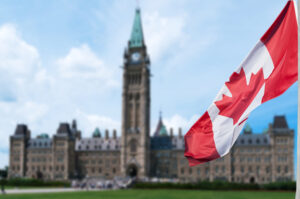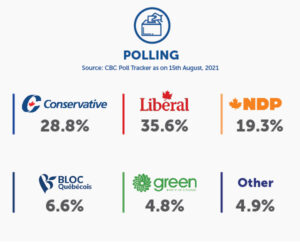State of Play: Canada’s 44th General Election Kicks-off
 Welcome to State of Play, StrategyCorp’s weekly analysis of the 2021 Federal Election.
Welcome to State of Play, StrategyCorp’s weekly analysis of the 2021 Federal Election.
State of Play is designed to take you past the hourly campaign media frenzy and instead provide in-depth and substantive analysis of the issues, people, and parties that make up Canada’s 44th General Election.
Over the next few weeks, StrategyCorp will be taking a look at the campaigns, party platforms, the debates, and some of the big themes in this campaign. Our PollTracker will aggregate the major polls over the course of the election so you can follow the movement of each party in the polls. We will also be featuring our Intended Consequences podcast which will bring you conversations and perspectives on the campaign and the issues shaping Canada’s future.
Campaigns matter, and there will no doubt be unpredictable twists and turns over the next 36 days. StrategyCorp is here to help you make sense of it all.
Today’s State of Play
Prime Minister and Liberal Party Leader Justin Trudeau visited Rideau Hall this morning and asked Governor General Mary Simon for a dissolution of the minority 43rd Parliament, which was granted.
Election Day will be Monday, September 20, a 36-day campaign.
The 43rd Parliament lasted one year and ten months. While that is slightly longer than the year and five months average for a minority Parliament in Canada, it is the briefest since 2004-05 when Paul Martin was Prime Minister.
The dominant theme of today’s campaign launch was the timing of the election. This is of course unwelcome for the governing party, but not at all unexpected. Trudeau was anticipating sharp challenges to his election timing and answered repeated questions without deviating from his message. In effect, the PM sought to gloss over the critique of his specific timing by broadening his definition of the election moment. Instead of explaining ‘why September 20?’ Trudeau asserted a general historical moment of choices to be made regarding post-COVID reconstruction, the global climate crisis, and a range of social issues. The PM also sought to turn from defence to offence by challenging his opponents to explain why they would ‘deny Canadian voters their say.’ Trudeau also expanded his offence against the Conservatives by raising the CPC’s policy of “reasonable accommodation” for Canadians who refuse to be vaccinated.
For their parts, all four opposition leaders pushed hard against the election timing, casting it as irresponsible and self-serving during COVID’s fourth wave, and a distraction from unfolding issues such as the Afghan government’s collapse. Official Opposition and Conservative Party Leader Erin O’Toole drew a contrast between Trudeau’s ‘self-serving’ election timing and his party’s policy offerings. Bloc Québécois Leader Yves-Francois Blanchet argued that Trudeau’s election call puts recent gains made by Quebec in jeopardy. NDP Leader Jagmeet Singh asserted that New Democrats in Parliament successfully pushed the opportunistic Liberals to more ambitious social policies, and that the election simply gets in the way of that positive dynamic. Green Party Leader Annamie Paul described the election as a distraction from the urgency of addressing the climate crisis.
The question arising from this calculated gamble by the Liberals is whether today’s chorus of controversy will be sustained and coalesce into a negative political dynamic, or fade as the campaign finally gets underway. Pressures to watch include the Conservatives regarding mandatory vaccination measures, heat from the NDP aimed at the Liberals regarding part-delivered promises, the workings of a suite of foreign affairs issues (e.g. imprisoned Canadians in China and the unfolding Afghan catastrophe), and the frequently-volatile mood of the Quebec electorate.
All in all, it makes for a fascinating 36 days on the campaign trail.
Who’s In Charge of Government When an Election Is Called
The over 230,000 Canadians who work in the public service don’t stop working during an election campaign. Key services and programs must continue to be administered by Canada’s professional public service, but political decisions come to a halt.
While the Prime Minister and Cabinet remain in office, able to react to global events or address domestic emergencies, their actions are confined and constrained by the caretaker convention.
StrategyCorp has a short analysis of the caretaker convention that explains how it works in principle and in practice, including during recent elections.
PollTracker

Keep tabs on how polling is shaping up over the election campaign with StrategyCorp’s poll tracker.
The Political Landscape as the Campaign Kicks Off
Canada’s 44th general election begins with the Liberals in an envious but not invulnerable position.
Trudeau benefits from the fact that Canadians have been in a relatively good mood. Last week, Abacus found that 46% of survey respondents think the country is headed in the right direction, a level of positivity “near the highest it has been in over 5 years and 11-points higher than at the start of the 2019 campaign.”
The Trudeau Liberals also enjoy high marks on their performance during the pandemic. Pollster Nik Nanos found that 50% of Canadians believe the Trudeau government did a good job of managing the crisis, while 23% say he did poorly. Another 26% are neutral. Almost three in four Canadians believe their personal finances are better or no worse than they were before the pandemic. At the same time, Canadians have strong views about whether Trudeau should have a majority or minority government. A Leger poll earlier this week notes that when Canadians were asked if they wanted Trudeau to win a majority, 56% said no, with only 24% saying yes.
As the StrategyCorp poll tracker suggests, public opinion surveys have been tracking positive for the Liberals over the past few weeks in the lead up to today’s election call.
Seat Projections
But seats are what matter in Canadian politics. Remember that the Conservatives won the popular vote in 2019, with many seats in Alberta and Saskatchewan won by large margins. A seat projection model at 338 Canada is giving a 56% likelihood of a Liberal majority, a 43% likelihood of a Liberal minority, and just a 2% chance that the Conservatives will win the most seats.
It is also notable that all of Canada’s provincial and territorial governments seeking re-election during the pandemic were re-elected, four of the five with a majority government. Three of these wins resulted in a move from a minority to a majority government. Tuesday’s election in Nova Scotia could continue this trend if the governing Liberals are able to secure a majority.
What Global and Canadian Pandemic Elections Tell Us
While it may be dangerous to draw conclusions based on just five elections, there is evidence internationally of increased support for incumbents during elections in other jurisdictions. During the pandemic, there were six national or state level elections held in Australia and New Zealand, jurisdictions with a similar Parliamentary system to Canada. All of them returned the incumbent, and four of six saw the incumbent increase its share of seats. A study of 15 Western European countries showed that the lockdown led to higher vote intention for the national incumbent. Of 26 national elections held in pure democracies during the pandemic in 2020, 17 or two-thirds saw the incumbent re-elected.
In Canadian elections during the pandemic, the average number of government seats in the legislature increased by 6%. The improvements ranged from a high of 15% more seats in British Columbia to a low of 3% more for the Saskatchewan Party’s already overwhelming majority government. Only Sandy Silver’s Yukon Liberals lost seats, falling from 10 to 8. This is consistent with national and sub-national elections in Australia and New Zealand, where the average number of government seats increased by an average of 4.4% after the election.

Of course, “unknown unknowns” in 2021 such as voter turnout, the state of the “fourth wave” of the pandemic, and mail-in voting could have unpredictable effects on the result.At dissolution, the Liberals held 155 or 46% of the seats in Parliament. They will need 170 seats to ensure a majority government and to elect a Liberal as Speaker. If the average 6% increase in seats happens federally, it would result in the Trudeau Liberals securing 175 seats or 52% of the House of Commons.
Make sure to subscribe to our newsletter to receive more of StrategyCorp’s federal election updates for the next five weeks.